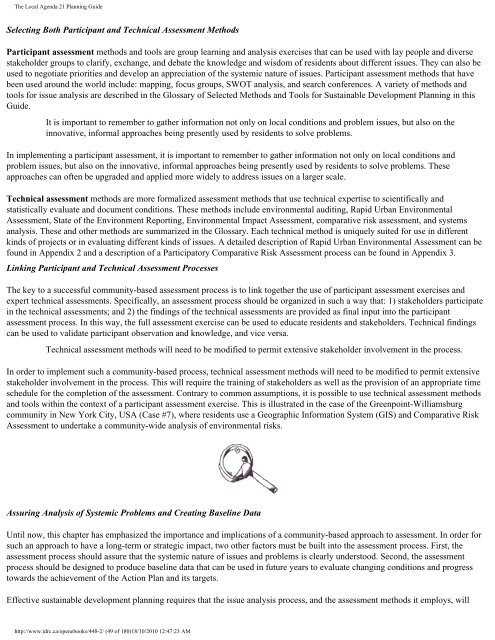The Local Agenda 21 Planning Guide - Democrats Against UN ...
The Local Agenda 21 Planning Guide - Democrats Against UN ...
The Local Agenda 21 Planning Guide - Democrats Against UN ...
Create successful ePaper yourself
Turn your PDF publications into a flip-book with our unique Google optimized e-Paper software.
<strong>The</strong> <strong>Local</strong> <strong>Agenda</strong> <strong>21</strong> <strong>Planning</strong> <strong>Guide</strong><br />
Selecting Both Participant and Technical Assessment Methods<br />
Participant assessment methods and tools are group learning and analysis exercises that can be used with lay people and diverse<br />
stakeholder groups to clarify, exchange, and debate the knowledge and wisdom of residents about different issues. <strong>The</strong>y can also be<br />
used to negotiate priorities and develop an appreciation of the systemic nature of issues. Participant assessment methods that have<br />
been used around the world include: mapping, focus groups, SWOT analysis, and search conferences. A variety of methods and<br />
tools for issue analysis are described in the Glossary of Selected Methods and Tools for Sustainable Development <strong>Planning</strong> in this<br />
<strong>Guide</strong>.<br />
It is important to remember to gather information not only on local conditions and problem issues, but also on the<br />
innovative, informal approaches being presently used by residents to solve problems.<br />
In implementing a participant assessment, it is important to remember to gather information not only on local conditions and<br />
problem issues, but also on the innovative, informal approaches being presently used by residents to solve problems. <strong>The</strong>se<br />
approaches can often be upgraded and applied more widely to address issues on a larger scale.<br />
Technical assessment methods are more formalized assessment methods that use technical expertise to scientifically and<br />
statistically evaluate and document conditions. <strong>The</strong>se methods include environmental auditing, Rapid Urban Environmental<br />
Assessment, State of the Environment Reporting, Environmental Impact Assessment, comparative risk assessment, and systems<br />
analysis. <strong>The</strong>se and other methods are summarized in the Glossary. Each technical method is uniquely suited for use in different<br />
kinds of projects or in evaluating different kinds of issues. A detailed description of Rapid Urban Environmental Assessment can be<br />
found in Appendix 2 and a description of a Participatory Comparative Risk Assessment process can be found in Appendix 3.<br />
Linking Participant and Technical Assessment Processes<br />
<strong>The</strong> key to a successful community-based assessment process is to link together the use of participant assessment exercises and<br />
expert technical assessments. Specifically, an assessment process should be organized in such a way that: 1) stakeholders participate<br />
in the technical assessments; and 2) the findings of the technical assessments are provided as final input into the participant<br />
assessment process. In this way, the full assessment exercise can be used to educate residents and stakeholders. Technical findings<br />
can be used to validate participant observation and knowledge, and vice versa.<br />
Technical assessment methods will need to be modified to permit extensive stakeholder involvement in the process.<br />
In order to implement such a community-based process, technical assessment methods will need to be modified to permit extensive<br />
stakeholder involvement in the process. This will require the training of stakeholders as well as the provision of an appropriate time<br />
schedule for the completion of the assessment. Contrary to common assumptions, it is possible to use technical assessment methods<br />
and tools within the context of a participant assessment exercise. This is illustrated in the case of the Greenpoint-Williamsburg<br />
community in New York City, USA (Case #7), where residents use a Geographic Information System (GIS) and Comparative Risk<br />
Assessment to undertake a community-wide analysis of environmental risks.<br />
Assuring Analysis of Systemic Problems and Creating Baseline Data<br />
Until now, this chapter has emphasized the importance and implications of a community-based approach to assessment. In order for<br />
such an approach to have a long-term or strategic impact, two other factors must be built into the assessment process. First, the<br />
assessment process should assure that the systemic nature of issues and problems is clearly understood. Second, the assessment<br />
process should be designed to produce baseline data that can be used in future years to evaluate changing conditions and progress<br />
towards the achievement of the Action Plan and its targets.<br />
Effective sustainable development planning requires that the issue analysis process, and the assessment methods it employs, will<br />
http://www.idrc.ca/openebooks/448-2/ (49 of 180)18/10/2010 12:47:23 AM










